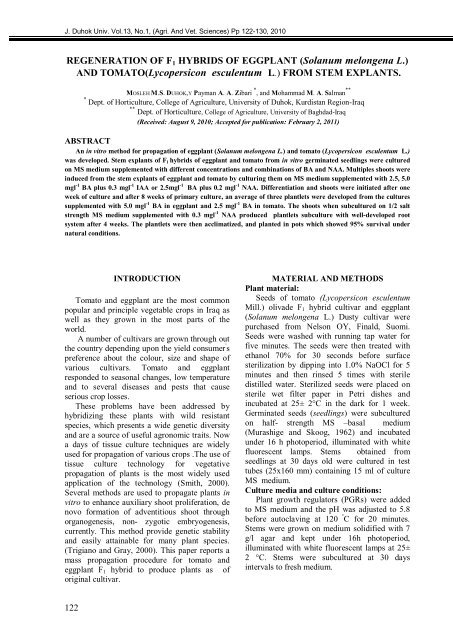The Influence Of Priming Two Cucumber Cultivar Seeds
The Influence Of Priming Two Cucumber Cultivar Seeds
The Influence Of Priming Two Cucumber Cultivar Seeds
You also want an ePaper? Increase the reach of your titles
YUMPU automatically turns print PDFs into web optimized ePapers that Google loves.
J. Duhok Univ. Vol.13, No.1, (Agri. And Vet. Sciences) Pp 122-130, 2010<br />
REGENERATION OF F1 HYBRIDS OF EGGPLANT (Solanum melongena L.)<br />
AND TOMATO(Lycopersicon esculentum L.) FROM STEM EXPLANTS.<br />
233<br />
MOSLEH M.S. DUHOK,Y Payman A. A. Zibari * , and Mohammad M. A. Salman **<br />
* Dept. of Horticulture, College of Agriculture, University of Duhok, Kurdistan Region-Iraq<br />
** Dept. of Horticulture, College of Agriculture, University of Baghdad-Iraq<br />
(Received: August 9, 2010; Accepted for publication: February 2, 2011)<br />
ABSTRACT<br />
An in vitro method for propagation of eggplant (Solanum melongena L.) and tomato (Lycopersicon esculentum L.)<br />
was developed. Stem explants of Fl hybrids of eggplant and tomato from in vitro germinated seedlings were cultured<br />
on MS medium supplemented with different concentrations and combinations of BA and NAA. Multiples shoots were<br />
induced from the stem explants of eggplant and tomato by culturing them on MS medium supplemented with 2.5, 5.0<br />
mgl -1 BA plus 0.3 mgl -1 IAA or 2.5mgl -1 BA plus 0.2 mgl -1 NAA. Differentiation and shoots were initiated after one<br />
week of culture and after 8 weeks of primary culture, an average of three plantlets were developed from the cultures<br />
supplemented with 5.0 mgl -1 BA in eggplant and 2.5 mgl -1 BA in tomato. <strong>The</strong> shoots when subcultured on 1/2 salt<br />
strength MS medium supplemented with 0.3 mgl -1 NAA produced plantlets subculture with well-developed root<br />
system after 4 weeks. <strong>The</strong> plantlets were then acclimatized, and planted in pots which showed 95% survival under<br />
natural conditions.<br />
INTRODUCTION<br />
Tomato and eggplant are the most common<br />
popular and principle vegetable crops in Iraq as<br />
well as they grown in the most parts of the<br />
world.<br />
A number of cultivars are grown through out<br />
the country depending upon the yield consumer ' s<br />
preference about the colour, size and shape of<br />
various cultivars. Tomato and eggplant<br />
responded to seasonal changes, low temperature<br />
and to several diseases and pests that cause<br />
serious crop losses.<br />
<strong>The</strong>se problems have been addressed by<br />
hybridizing these plants with wild resistant<br />
species, which presents a wide genetic diversity<br />
and are a source of useful agronomic traits. Now<br />
a days of tissue culture techniques are widely<br />
used for propagation of various crops .<strong>The</strong> use of<br />
tissue culture technology for vegetative<br />
propagation of plants is the most widely used<br />
application of the technology (Smith, 2000).<br />
Several methods are used to propagate plants in<br />
vitro to enhance auxiliary shoot proliferation, de<br />
novo formation of adventitious shoot through<br />
organogenesis, non- zygotic embryogenesis,<br />
currently. This method provide genetic stability<br />
and easily attainable for many plant species.<br />
(Trigiano and Gray, 2000). This paper reports a<br />
mass propagation procedure for tomato and<br />
eggplant F1 hybrid to produce plants as of<br />
original cultivar.<br />
MATERIAL AND METHODS<br />
Plant material:<br />
<strong>Seeds</strong> of tomato (Lycopersicon esculentum<br />
Mill.) olivade F1 hybrid cultivar and eggplant<br />
(Solanum melongena L.) Dusty cultivar were<br />
purchased from Nelson OY, Finald, Suomi.<br />
<strong>Seeds</strong> were washed with running tap water for<br />
five minutes. <strong>The</strong> seeds were then treated with<br />
ethanol 70% for 30 seconds before surface<br />
sterilization by dipping into 1.0% NaOCl for 5<br />
minutes and then rinsed 5 times with sterile<br />
distilled water. Sterilized seeds were placed on<br />
sterile wet filter paper in Petri dishes and<br />
incubated at 25± 2°C in the dark for 1 week.<br />
Germinated seeds (seedlings) were subcultured<br />
on half- strength MS –basal medium<br />
(Murashige and Skoog, 1962) and incubated<br />
under 16 h photoperiod, illuminated with white<br />
fluorescent lamps. Stems obtained from<br />
seedlings at 30 days old were cultured in test<br />
tubes (25x160 mm) containing 15 ml of culture<br />
MS medium.<br />
Culture media and culture conditions:<br />
Plant growth regulators (PGRs) were added<br />
to MS medium and the pH was adjusted to 5.8<br />
before autoclaving at 120 ° C for 20 minutes.<br />
Stems were grown on medium solidified with 7<br />
g/l agar and kept under 16h photoperiod,<br />
illuminated with white fluorescent lamps at 25±<br />
2 °C. Stems were subcultured at 30 days<br />
intervals to fresh medium.



